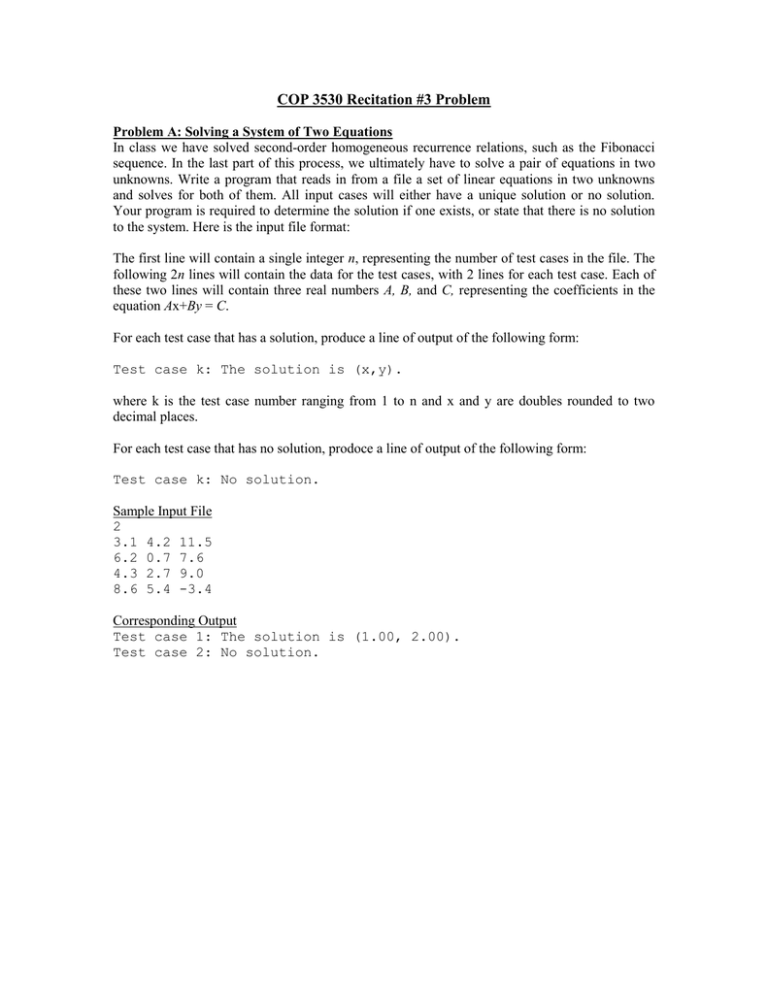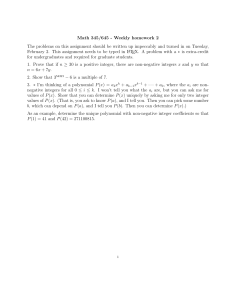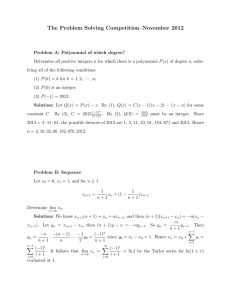COP 3530 Recitation #3 Problem
advertisement

COP 3530 Recitation #3 Problem Problem A: Solving a System of Two Equations In class we have solved second-order homogeneous recurrence relations, such as the Fibonacci sequence. In the last part of this process, we ultimately have to solve a pair of equations in two unknowns. Write a program that reads in from a file a set of linear equations in two unknowns and solves for both of them. All input cases will either have a unique solution or no solution. Your program is required to determine the solution if one exists, or state that there is no solution to the system. Here is the input file format: The first line will contain a single integer n, representing the number of test cases in the file. The following 2n lines will contain the data for the test cases, with 2 lines for each test case. Each of these two lines will contain three real numbers A, B, and C, representing the coefficients in the equation Ax+By = C. For each test case that has a solution, produce a line of output of the following form: Test case k: The solution is (x,y). where k is the test case number ranging from 1 to n and x and y are doubles rounded to two decimal places. For each test case that has no solution, prodoce a line of output of the following form: Test case k: No solution. Sample Input File 2 3.1 4.2 11.5 6.2 0.7 7.6 4.3 2.7 9.0 8.6 5.4 -3.4 Corresponding Output Test case 1: The solution is (1.00, 2.00). Test case 2: No solution. Problem B: Sum Solver In class we have had to solve several types of summations. One simple type of summation that 10 occurs is a polynomial, such as (i 2 2i 3) . Given an input polynomial, as well as a start i 3 and end index, write a program that determines the value of the sum. All coefficients and end results are guaranteed to be integers that fit in a regular 32-bit int. Here is the input file format: The first line will contain a single integer n, representing the number of test cases in the file. The following n lines will contain one test case a piece. The first number for each test case will be an integer k (0 < k < 10), where k stands for the degree of the polynomial. The following k+1 integers separated by spaces on the line represent the coefficients (highest exponent to lowest exponent) of each term. The last two integers on the line represent the low and high bound of the summation, respectively. (You are guaranteed that the low bound is less than or equal to the high bound.) For each test case, output a line with the following format: Test case k: Sum = X. where X is the integer value of the desired sum. Sample Input File 2 2 1 2 3 3 10 3 1 0 0 2 4 4 Corresponding Output Test case 1: Sum = 508. Test case 2: Sum = 66.



